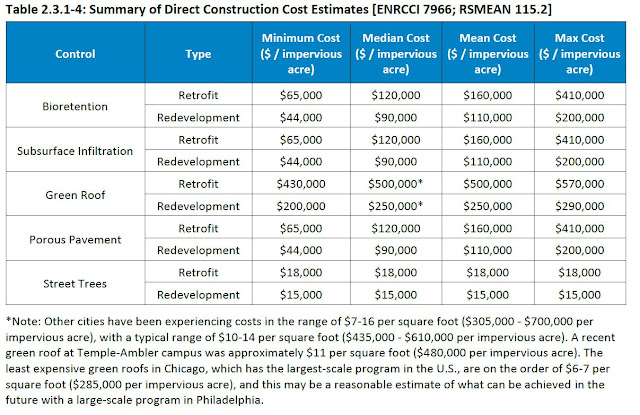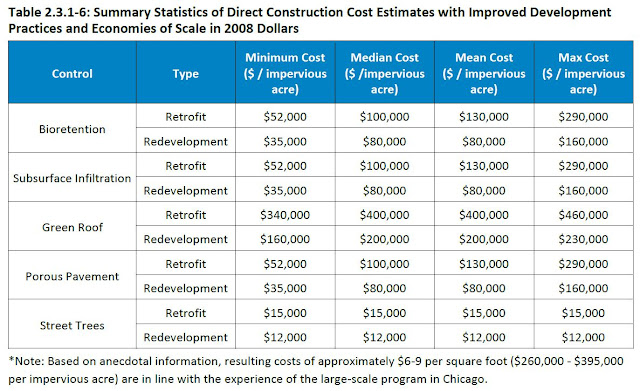 |
| COVID-19 - observed data on ICU cases and projected capacity |
In early April, COVID-19 ICU cases were projected to increase to 1200 in a best case to about 1500 in a worst case in Ontario, increasing considerably from actual data counts in late March. The chart at right shows that ICU beds peaked at under 300 cases by mid April, a fraction of the best case model prediction, and has declined since. So model projections should be viewed with some caution, and the reliability of the projections should be questioned and validated where possible with real data.
Predicting future weather extremes due to climate change effects has a great deal of uncertainty as well. The recurrence time of extreme rainfall is predicted to decrease due to climate change effects, meaning that the "return period" of storms would become smaller. For example, a rainfall event that had a return period of 35 years today (meaning a probability of occurring in any year of 1/35, or 1 in 35) has been predicted to occur every 12 years in the future (i.e., a higher probability of happening each year of 1/12 or 1 in 12 ... that a greater chance than today's 1/35). That is what is projected to occur in Canada from now to 2100.
The above example on decreasing recurrence times is from a simulation presented in Canada's Changing Climate Report by Environment Canada (link: https://changingclimate.ca/CCCR2019/). It is for a future scenario with several assumptions about growth and emissions called the RCP8.5 scenario, representing a Representative Concentration Pathway of just one of several future scenarios. The shift in 24-hour precipitation recurrence times are presented on Figure 4.20 b shown below:
 |
| Canada's Changing Climate Report Figures 4.20 b), Projected Extreme Precipitation Recurrence Time / Return Periods for Past, Present and Future Time Periods, RCP8.5 Model Simulation Scenario |
As annotated above, today's recurrence time is noted as 35 years, the future recurrence time is 12 years and the past time was 50 years. So the model predicts these shifts in recurrence time (return period) and annual probability:
Period Recurrence Time Probability Each Year
1986-2005 50 years 2.0 % (1/50)
2016-2035 35 years 2.9 % (1/35)
2081-2100 12 years 8.3 % (1/12)
Some have misinterpreted the theoretical, simulation model changes from past to present as 'actual' observed changes in extreme precipitation when in fact the Environment Canada report clearly notes these are 'projected changes' and are 'simulated by Earth system models' for the scenario RCP8.5. A different scenario's simulated results, with different assumed emissions and growth, and different recurrence time shifts are presented in Figure 4.20 a) as well.
 |
| CBC News In Our Backyard - Flooding |
CBC News report: "Climate change is making extreme rainfall a more frequent occurrence. Storms that historically happened only once every 50 years are now coming every 35 years or less. By the end of the century, they could happen once every 12 years on average, according to a recent climate report from Environment Canada. All this increases the potential for urban flooding."
 |
| CBC News In Out Backyard Extreme Rainfall Frequency - Past, Present, and Future Recurrence Times Confuses Simulation Model Projections With Observed, Historical Trends |
So while predicted changes are only theoretical, CBC News mistakenly reports that changes have already occurred and are 'now coming' at smaller recurrence intervals (i.e., higher frequency and higher probability each year).
The CBC Ombudsman has indicated that the CBC should be careful to distinguish between past, present and future extreme rainfall trends, as noted in a recent post: https://www.cityfloodmap.com/2020/05/past-present-or-future-cbc-ombudsman.html
We agree.
A review of historical extreme rainfall trends in one region of Canada affected by may flooding events has shown no decrease in the recurrence time, or return period, of extreme precipitation. A previous post showed that today's 35 year storms are actually occurring less frequently than in the past. In southern Ontario, long term climate station observations show that the average 25 to 50 year rainfall intensities today are actually slightly smaller than they were considering observations up to 1990. See previous post: https://www.cityfloodmap.com/2020/05/southern-ontario-extreme-rainfall.html
Analysis of the Version 3.10 Engineering Climate Datasets IDF Files updated in March 2020 show that southern Ontario long term rainfall intensities have decreased slightly since 1990, on average by 0.1%. The 50 year return period rainfall intensities are on average unchanged.
If 50 year rainfall intensities actually occurred more frequently and now occur at a 35 year return period, as CBC mistakenly reported, then the magnitude of the 50 year intensities would have had to increase by about 6%. This considers the example long term climate station at Toronto's Pearson International Airport - the 35 year 24-hour rainfall intensity of 99.7 mm at the airport would have to increase to the 50 year intensity of 105.7 mm. Back in 1990, the 50 year 24-hour rainfall intensity at the airport was 109.3 mm, meaning the 50 year rainfall has decreased by several percentage points. Here are the 1990 data (copied from my top desk drawer):
Here are the recently updated IDF values from Environment Canada considering data up to 2017:
Climate models that predict more frequent future rainfall intensities, characterized by shorter recurrence times (i.e., lower return periods = higher probabilities of occurrence) are not necessarily in step with observations (see Toronto airport example above and previous post on southern Ontario long term stations). Here is a comparison of past trends in 100-year rainfall intensity based on observed data and projections from various studies - the actual data curve is already 'flat', so the need to flatten the curve can only be made based on projections and not past data.
While in the case of COVID-19, the need for "flattening the curve" is clear given the close scrutiny of observed data that has shown rising counts of infections, hospitalizations or deaths - that gives clear direction on actions to be taken to mitigate observed phenomena. In the case of COVID-19, these values may even increase at an exponential rate. In contrast, the IDF curve trends are largely flat if not already declining based on observed data in some regions. Any change in extreme rainfall trends has been explained by natural variations (i.e., trends can go up).
***
There is a long-standing gap in the media mixing up predictions of extreme weather and actual Environment Canada observed data trends - sometimes a single report can start a narrative that can go unchecked for some time. The "Telling the Weather Story" report is one such example where a theoretical shift in extreme weather has been reported, and repeated endlessly in the media as actual data when it is clearly not:





























